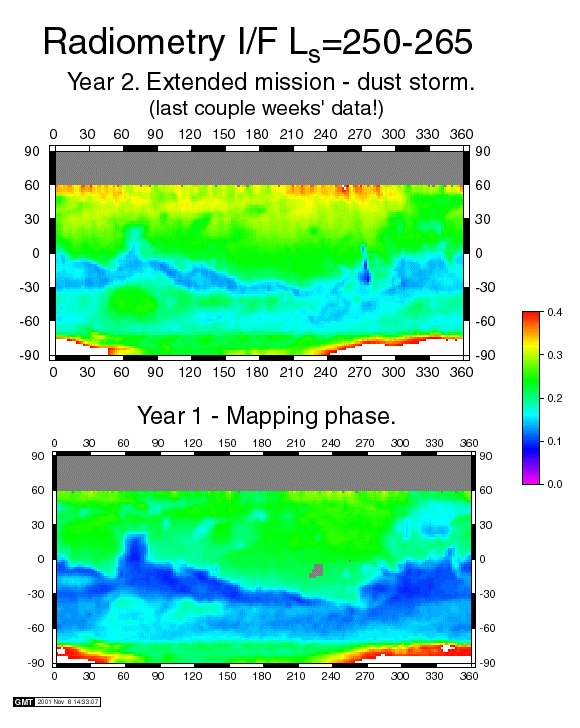

The MOLA instrument has the ability to measure the reflectance of the Martian surface at 1064 nm in a passive mode, i.e., without use of the laser or ranging function. Reflectance is measured from background noise counts that in ranging mode are used to set the detection threshold of the instrument on a once per second basis. Passive data have been collected since MOLA began operating at Mars in 1997 and were used in an operational sense to adjust the detection threshold to optimize the range measurement. But until the oscillator ceased function during the summer of 2001, the MOLA reflectance measurements were never analyzed in terms of their science value. The attention of the science team has now turned to operating MOLA as a single channel radiometer.
Here is a comparison of MOLA passive measurements obtained in altimetry mode and radiometry mode.
|
|
|
Frequency | 8 Hz | 1 Hz | Resolution | 375-m along track | 3-km along track | Noise statistics | 104 counts on 2 channels | Log counts | S/N | 100:1 | 10:1 | MGS Pitch Angle | 16° | 0° (Nadir viewing) | Profiles Collected | 1533 | About 9000 | Geolocation | Rectified to 1/16° | About 100 m |
To achieve the highest sensitivity during ranging, the MOLA receiver detection threshold was dynamically adjusted to be as low as possible while maintaining a pre-determined false alarm rate. The average false alarm rate is monitored in real time on board MOLA via a noise counter, whose output is input to the threshold control loop. The false alarm rate at a given threshold is a function of the detector output noise, which is the sum of the detector shot noise due to the background light seen by the detector and the dark noise. Noise counts are accumulated via a single high sensitivity "pixel" within MOLA's 0.8-mrad field of view for the spectral region of 1064 nm. The brightness of the scene viewed by the MOLA detector varies and depends on the sun-Mars distance, the solar illumination angle, atmospheric backscatter and attenuation conditions, and the surface reflectivity at 1064 nm.
The MOLA noise counter output is a function of the received solar optical power reflected off Mars surface and the MOLA detection threshold. The relationship between the three is given by an integral equation that can be evaluated numerically. The radiance of Mars can then be determined by dividing the optical power by the solid angle subtended by the MOLA receiver telescope, the optical bandwidth, and the Mars surface area within the receiver field of view. The phase angle corresponding to the sun-Mars-MOLA angle is available from the MGS database. Using this approach the MOLA team is now analyzing passive observations obtained during the MGS mapping and extended mission when the instrument was in altimetry mode as well as in the E2 mission with the instrument in radiometry mode.
Click here to view radiometry measurements collected during the past week of mapping.
MOLA's passive measurements will be archived and released for analysis in the same manner as the altimetry observations.